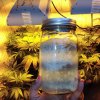MjMama
Well-Known Member
Hi everyone. I've been working on making my own lacto serum, similar to the expensive EM1 product. Sorry if this info has already been shared here.
First, take a 1/4 cup of rice and shake it in 1 cup of warm water until the water gets cloudy.

This is harvesting the starch from the rice that will attract beneficial bacteria from the air into the water. Strain and keep the rice rinse water, and discard the rice. You can add the used rice to your compost pile so it doesn't go to waste. Microbes and whatnot love rice.
Keep the starchy water in a jar under your sink for a week or two to attract the bacteria we are seeking. After the wait period I drain off and keep the top 95 percent of the water and leave the thick white sludge that has formed at the bottom. We don't need that part.
Now, for every one part rice water, add 10 parts milk. So for 1 cup water it takes 10 cups of milk. Any type of milk is fine. I just filled a mason jar to the top and called that good enough. It doesn't have to be an exact science. Again, let this mixture sit. This time a few days should be all it takes for the milk to curdle. The milk solids will rise to the top and look like cottage cheese.

Strain out the curds and keep the yellow liquid that remains. Now mix the yellow liquid 50/50 with molasses and you have your finished product that can be stored for up to 6 months.
I use 2-3 tbs per gallon for foliar and 1/3 cup per gallon for soil drench.
The cheese curds can be fed to dogs or added to the compost. My dogs love it and it's great for their digestive health. It's a probiotic for plants and pets.
First, take a 1/4 cup of rice and shake it in 1 cup of warm water until the water gets cloudy.

This is harvesting the starch from the rice that will attract beneficial bacteria from the air into the water. Strain and keep the rice rinse water, and discard the rice. You can add the used rice to your compost pile so it doesn't go to waste. Microbes and whatnot love rice.
Keep the starchy water in a jar under your sink for a week or two to attract the bacteria we are seeking. After the wait period I drain off and keep the top 95 percent of the water and leave the thick white sludge that has formed at the bottom. We don't need that part.
Now, for every one part rice water, add 10 parts milk. So for 1 cup water it takes 10 cups of milk. Any type of milk is fine. I just filled a mason jar to the top and called that good enough. It doesn't have to be an exact science. Again, let this mixture sit. This time a few days should be all it takes for the milk to curdle. The milk solids will rise to the top and look like cottage cheese.

Strain out the curds and keep the yellow liquid that remains. Now mix the yellow liquid 50/50 with molasses and you have your finished product that can be stored for up to 6 months.
I use 2-3 tbs per gallon for foliar and 1/3 cup per gallon for soil drench.
The cheese curds can be fed to dogs or added to the compost. My dogs love it and it's great for their digestive health. It's a probiotic for plants and pets.


